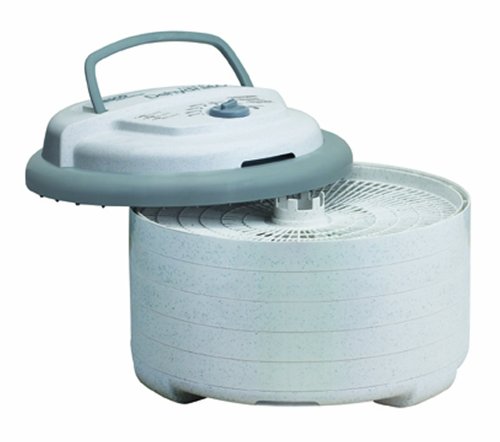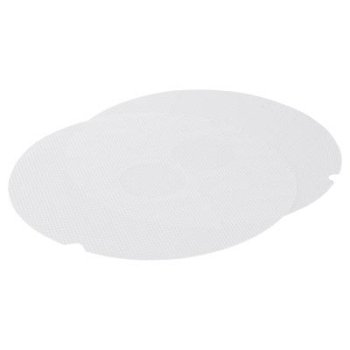 The NESCO Professional Food & Jerky Dehydrator has more power than most dehydrators -- 700 watts -- which means faster drying time. You will have results in hours, not days. The top mounted fan with patented Converga-Flow action pressurizes air downward through the outer ring and horizontally across each individual tray, converging at the center, for fast, even drying. No need to rotate trays. The adjustable thermostat allows you to dry different foods at proper temperatures (95-155 F), providing the flexibility to produce the best drying results. As your needs grow, the Professional Food & Jerky Dehydrator can be expanded up to 12 trays.
The NESCO Professional Food & Jerky Dehydrator has more power than most dehydrators -- 700 watts -- which means faster drying time. You will have results in hours, not days. The top mounted fan with patented Converga-Flow action pressurizes air downward through the outer ring and horizontally across each individual tray, converging at the center, for fast, even drying. No need to rotate trays. The adjustable thermostat allows you to dry different foods at proper temperatures (95-155 F), providing the flexibility to produce the best drying results. As your needs grow, the Professional Food & Jerky Dehydrator can be expanded up to 12 trays.After you have harvested your vegetables you might not be sure what you should do with them. Even a large family will have a hard time eating a steady supply of fresh organic vegetables. The way to avoid wastage is to store your vegetables in your home.
It is true that some vegetables are easier to store than others but most organic vegetables can be stored and saved in some way or another.
There are actually many ways to store your harvest so do not get frustrated if you feel that you have grown more than you can eat. Many grocery stores sell mason jars and supplies needed for making preserves and canning vegetables along with instructions on how to do this. The same stores sell cheesecloth which is great for placing vegetables on when drying if they are air drying.
Food dehydrators can also be used for drying your vegetables along with your oven. When using an oven to dry vegetables set it for the lowest setting, usually 140 degrees, and watch carefully to make sure the vegetables are drying out and not roasting.
Lettuce
Once you have harvested all of your lettuce you can wash it, remove the core, and pat it dry with a towel. When you have finished store it in a plastic bag and put it in your refrigerators crisping section. This will help your lettuce remain crisp for up to a week.
Since it is harder to store vegetables for a long period of time it is recommended that you harvest your lettuce and start using it even before it has reached full growth. When it has reached full growth use what you can, store what you can use, and offer the rest to friends and family members. They will appreciate some fresh organic salad to use in their salads or to place on their sandwiches.
Root Vegetables
Root vegetables can often store longer than the other vegetables you harvest as long as they are harvested on time and correctly. Make sure your vegetables have not been bruised or damaged during the harvest. If they have been damaged throw them away since the spoilage can spread if you are not careful.
Many root vegetables such potatoes, carrots, sweet potatoes, and more can be stored in a cool, dark, dry place such as a root cellar or some pantries. Other root vegetables (carrots) can be dried with a food dehydrator or even in an oven set to a very low heat setting. Some vegetables such as turnips can even be stored in a refrigerator crisper, especially if they are going to be used soon.
Tomatoes
There are many ways to store tomatoes and that is a great thing since tomatoes are popular with many organic gardeners. Tomatoes can be stored well on a counter top or in a window sill if they are still a bit green. They can also be stored in the refrigerator.
Some people will dry tomatoes for later use in sauces or even preserve them. Tomatoes preserves either sweet preserves with ripened tomatoes or pickle preserves with green tomatoes can be a winter time treat.
Onions
Onions will store wonderfully in any dry, dark place. As long as the onions have not been bruised and have no sign of moisture they can be stored in a pantry or attic for a long time.
Beans and Peas
Beans and peas can often be harvested as needed but once it is time to store them there are several methods that can be used. Peas and beans can both be stored in bags in the refrigerator for several days. They also can be canned with the proper equipment. Beans can also be dried which is a popular way to store them. Once beans are dried and bagged they can later be soaked and cooked.
Corn
Corn can be stored in the refrigerator or, once the husk is removed, frozen for a long time. The kernels can also be dried, stored, and creamed at a later date.
Learn about the redbud tree and the weeping cherry tree at the Tree Facts site.
dehydrator

